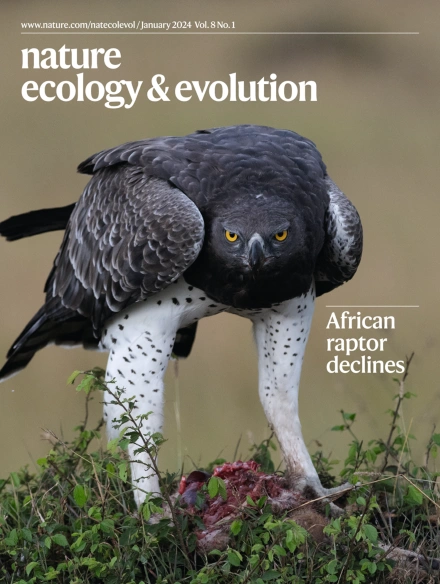一种新的Hox基因启动子促进了斑蝶翅膀眼斑适应性表型可塑性的进化。
IF 13.9
1区 生物学
Q1 ECOLOGY
引用次数: 0
摘要
适应性表型可塑性使生物体能够在不同的环境中表现出不同的表型,但在宏观进化尺度上,对促进可塑性进化的基因组变化知之甚少。在这里,结合组织特异性转录组学、比较基因组学和基因组编辑,我们表明,温度介导的蝴蝶眼点翅膀图案大小的可塑性,一种衍生的季节性适应,估计在约6000万年前在satyrid分支(约2700个现存物种)的基础上进化而来,是由Hox基因Antennapedia (Antp)在眼点发育中的招募所推动的。在斑蝶中,Antp以温度依赖的方式调节眼点的大小,增加了可塑性水平。眼点的Antp选择是由一种新的眼点特异性启动子的进化所驱动的,当这种启动子在一种模型眼点中被破坏时,会降低可塑性水平。我们发现,在一个保守的发育基因中,一个类群特异性的顺式调控创新推动了一个大进化支系动物适应性表型可塑性的进化。本文章由计算机程序翻译,如有差异,请以英文原文为准。
A novel Hox gene promoter fuels the evolution of adaptive phenotypic plasticity in wing eyespots of satyrid butterflies.
Adaptive phenotypic plasticity allows organisms to display distinct phenotypes in response to variable environments, but little is known about the genomic changes that promote the evolution of plasticity on a macroevolutionary scale. Here, combining tissue-specific transcriptomics, comparative genomics and genome editing, we show that temperature-mediated plasticity in the size of butterfly eyespot wing patterns, a derived seasonal adaptation estimated to have evolved ~60 million years ago at the base of the satyrid clade (~2,700 extant species), is fuelled by the recruitment of a Hox gene Antennapedia (Antp) to eyespot development. In satyrid butterflies, Antp regulates eyespot size in a temperature-dependent manner, increasing plasticity levels. The cooption of Antp to eyespots was driven by the evolution of a novel eyespot-specific promoter in satyrid genomes, which when disrupted in a model satyrid, Bicyclus anynana, reduced plasticity levels. We show that a taxon-specific cis-regulatory innovation in a conserved developmental gene fuelled the evolution of adaptive phenotypic plasticity across a large clade of animals.
求助全文
通过发布文献求助,成功后即可免费获取论文全文。
去求助
来源期刊

Nature ecology & evolution
Agricultural and Biological Sciences-Ecology, Evolution, Behavior and Systematics
CiteScore
22.20
自引率
2.40%
发文量
282
期刊介绍:
Nature Ecology & Evolution is interested in the full spectrum of ecological and evolutionary biology, encompassing approaches at the molecular, organismal, population, community and ecosystem levels, as well as relevant parts of the social sciences. Nature Ecology & Evolution provides a place where all researchers and policymakers interested in all aspects of life's diversity can come together to learn about the most accomplished and significant advances in the field and to discuss topical issues. An online-only monthly journal, our broad scope ensures that the research published reaches the widest possible audience of scientists.
 求助内容:
求助内容: 应助结果提醒方式:
应助结果提醒方式:


